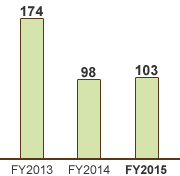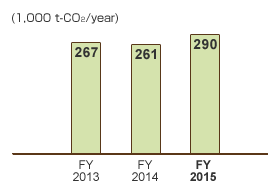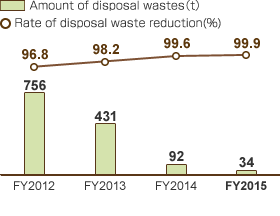- Home
- Sustainability
- Social and Environmental Report (Download)
- Environmental Report - Social Responsibility 2016
Environmental ReportSocial Responsibility 2016
Recognizing that our business activities affect the entire planet and that protecting the global environment is essential for our survival and activity, we work voluntarily and proactively to protect the environment under the Nisshin Seifun Group's Basic Environmental Policy, including initiatives to reduce waste and CO2 emissions and to effectively use resources and energy.
Mid-term Environmental Target of Nisshin Seifun Group
CO2 Emissions Reductions to Prevent Global Warming
- 26% CO2 emissions reduction on fiscal 2013 levels by fiscal 2030 (Japan)
- 7.8% reduction of consumption rate on fiscal 2013 levels by fiscal 2030 (Globally ex-Japan)
Efficient Use of Resources for Recycling Society
- Maintain zero-emission throughout Nisshin Seifun Group (Japan)
- Endeavor to achieve zero-emissions at each business site (Japan) by fiscal 2020
Material Balance
We have identified the major environmental impacts of our operations as electricity and water consumption, CO2 and waste emissions. We strive to promote effective environmental management and reduce environmental impacts through such means as understanding our footprint from production and distribution to consumer use and eventual disposal of residual packaging.




* Based on Act concerning the Promotion of Utilization of Recyclable Food Waste
Environmental Management
Under the leadership of the Director for Environmental Issues, we implement our Group Environmental Policy to conduct business in an environmental responsible manner. We evaluate each business site, including offices and plants for compliance with laws and regulations through internal audit according to our stringent standards. We also ensure our continuous improvement through group-wide certificated Environmental Management System under ISO14001.
| Number of operating companies |
Number of sites |
Results | ||
|---|---|---|---|---|
| Improvement orders |
Improvement recommendations |
|||
| FY2013 | 12 | 23 | 1 | 1 |
| FY2014 | 13 | 23 | 0 | 0 |
| FY2015 | 15 | 23 | 0 | 0 |
Climate Protection

We have been thoroughly reviewing the Group-wide use of electricity by introducing energy-efficient facilities at our plants and energy-saving air-conditioners, lighting apparatuses and OA equipment at our offices.
Also, we used green electricity to cover a part of domestic power usage.
Although we accomplished our group’s original target, from the effect of increase in production and by the addition of CO2 emissions of newly acquired overseas companies, total CO2 emission has been increased since 2013.
High level of Energy Conservation Throughout the Nisshin Seifun Group

We are working to efficient energy use to reduce environmental impact from our operation. Nine of the fifteen companies within our group subject to the Energy Conservation Act have been achieved “Rank S”* as the highest ranking for excellent companies in energy saving.
The new line launched within the Nisshin Seifun Chita Plant in May 2015 is a state-of-the-art production line with an integration of many milling technologies developed over our company's long history. By installing highly-efficient motors and shorten flour conveying distance by deploying machinery compactly, the line achieves significant energy savings for stable and efficient production of flour.
*The evaluation system under the Energy Conservation Act in Japan
Introduction of Renewable Energy Facilities

The Tsurumi Plant of Nisshin Seifun and the Tatebayashi Plant of Nisshin Foods installed solar photovoltaic facilities. The facility at the Tsurumi Plant is expected to generate power equivalent to annual consumption of 160 households, and to relieve the environmental impact by reducing approximately 250 tons of CO2 emissions annually compared with thermal power plant.
Waste Reduction

*Excludes overseas sites
We actively worked on reducing waste on a group-wide basis by improving production efficiency and reviewing procedures at the manufacturing division, as well as strengthening supply and demand and inventory management at the sales division. Additionally we made efforts to promote the use of waste for fertilizers and foodstuffs. As a result, final disposal waste in FY2015 reduced nearly 99.9% from that in FY2000.







